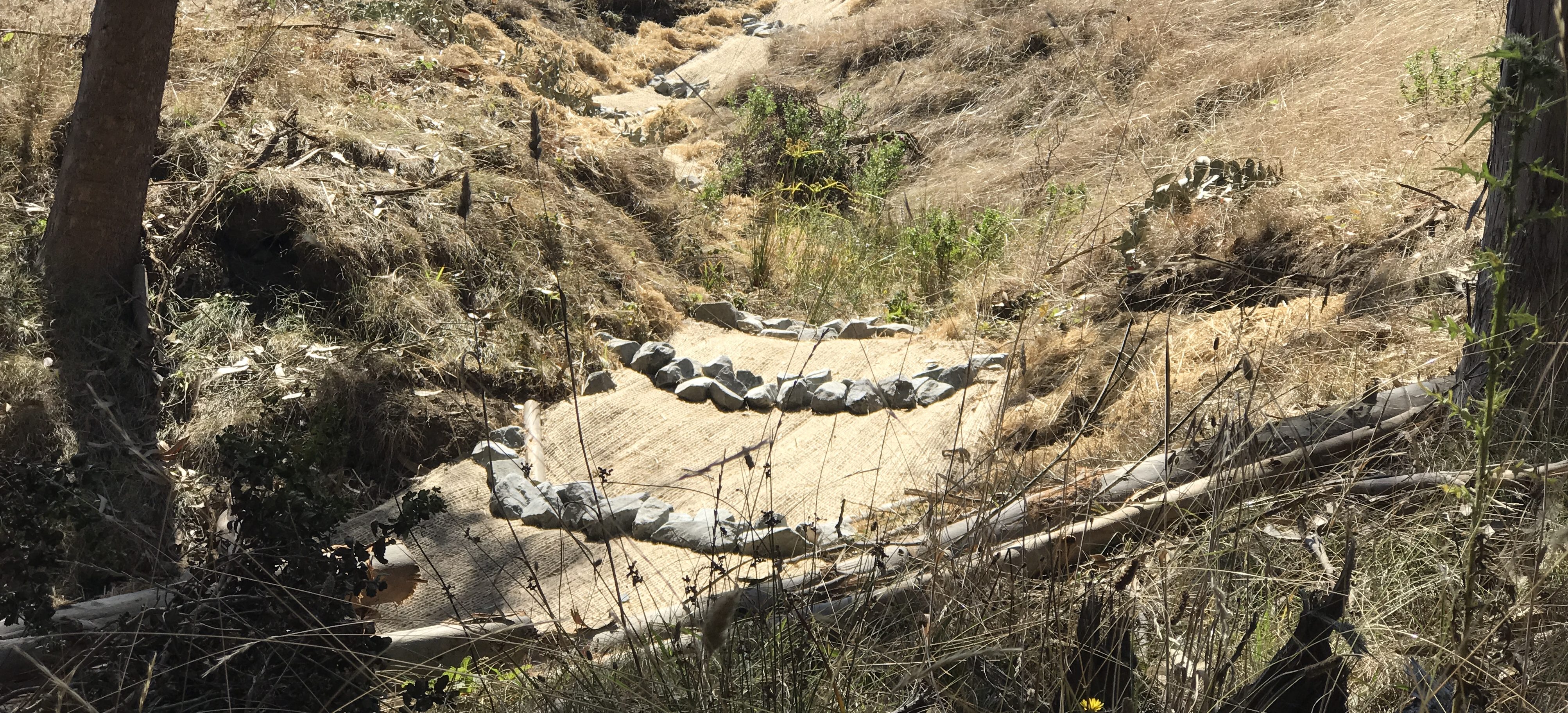
One of the biggest responsibilities of a land manager is to preserve and improve the soils of the land. Rain and water flow will always create some erosion but our goal is to minimize the erosion and to have the rate of new top soil formation exceed the rate at which our topsoil flows into ours creeks and ocean. Also, areas where water flows and collects can be the most productive and important areas on the ranch for plants and animals. There is more water available in the soil and there is potential for the soils to be deeper and more fertile as the drainage areas collect sediment that flows from the hills. Our goal on the ranch is to have healthy productive vegetation that will slow water flows and capture sediment in all of our drainage areas.
One of the most destructive and easiest to repair erosion features on a ranch is an upland head cut. This is a vertical face of active erosion where there are not enough plants to slow the water and protect the soil. Cattle like wet areas and their concentrated hoof action can create head cuts with poorly managed grazing.
Bay Hill Gully
We are developing our techniques for using organic matter, soil and grass for repairs instead of intense rock armor. This requires more work and attention but we believe it provides a better long term result with less expensive materials. This gully is on a steep hillside but has a small watershed. It’s fed by a seasonal spring so the erosion was probably caused by animals trampling the moist vegetation and exposing bare soil to the flowing water. There are more issues up the hill but its too steep to access with an excavator so we have focused our repair on the bottom section and hope to capture any sediment that flows down the hill before it reaches the creek.
The repair process was to shape the edges of the gully and ensure there was good topsoil in the bottom of the gully. We then added a layer of compost, and fast growing seed. We also layered in some the grass and seed from the top layer removed from the site. This provides native seed bank in the bottom of the drainage. Straw was added to protect the soil from water flow and jute netting holds the straw in place. The rock lines keep the netting and straw in contact with the soil and help keep flowing water spread out to minimize it’s force on the soil. We had watered the completed work to sprout the grass and stabilize the soil. To keep soil stable on a steep hill like this, you need healthy living soil covered with grass. The soil organic matter, roots, fungi and microbe produce a “glue” that holds the soil together against flowing water. By irrigating we give the soil a chance to heal before the rains and cold weather. The site needs to be checked throughout the rainy season and potentially repaired with straw and grass plugs. There is a electric fence around the gully and animals will be excluded while the soil heals.
Freestone Ranch Large Gully
There large gully on Freestone Ranch is probably 50 years old. Small head cuts over time led to a 600′ long gully that sent around 15,000 cubic yards of soil into our creeks. It was fairly stable when we came to the ranch but there was a small active head cut at the bottom of the gully that was starting to work it’s way up. We did a small repair and excluded the cattle with an electric fence and now, the gully is no longer eroding and is full of lush and diverse native vegetation. It’s a favorite place for the deer to rest in the moist soft bottom. There is also a small gully in the upper right of the photo where we did repairs, tree planting and cattle exclusion.
Freestone Ranch RCD Head Cut Repair
Another example is the Gold Ridge RCD head cuts repairs pictured above on Freestone Ranch. The RCD removed topsoil to shape a smooth contour and then armored the area with rock. They also funded materials for an electric fence to exclude the cattle from the area. We have planted willows to encourage vegetation in that rocked area.
Bay Hill Tunnel Gullies
In the photos above from the Bay Hill Ranch, we were able to take some top soil that had been captured in a pond and move it back up to fill the gullies. The upper gully in the photo actually drained into an underground tunnel. The water was flowing into a rodent tunnel that became enlarged over time and caused a head cut and gully to form above. The after photo shows a simple contour but the simple shape means the top soil is staying where it belongs instead of filling in our pond. Our rotational grazing and lower stocking level make the cow trails pronounced in the 2017 photo.
Bay Hill Head Cut
We brought some sediment recovered from a pond and filled in this head cut to keep it from continuing to progress up the hill. There are a few redwood trees planted in the area to see how they will do. It’s a moist area with deep soils so they are doing fairly well but the spot is probably too windy and the small redwood is showing some wind sculpting already.
Bay Hill Small Drainage
This small drainage is in a moist area. It has good diverse native vegetation but cattle and sheep trailing along the moist bottom has created a series of head cuts in the bottom. We repaired the top head cut to keep it from continuing to move up into the top of the drainage.
























You must be logged in to post a comment.